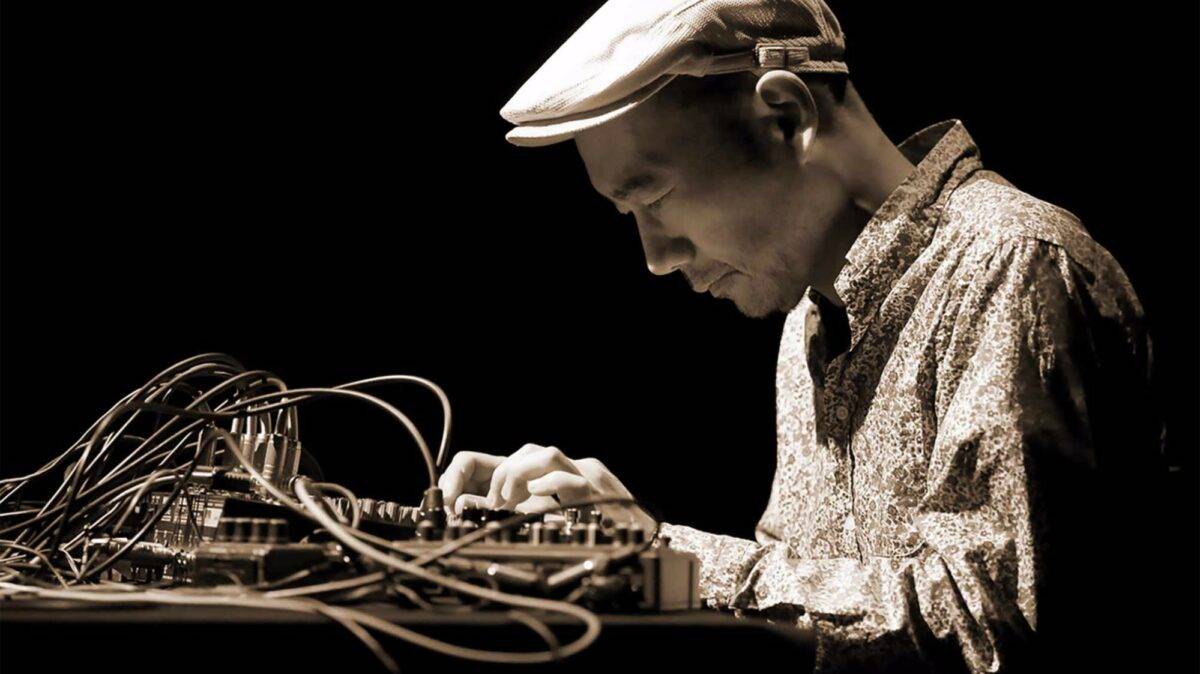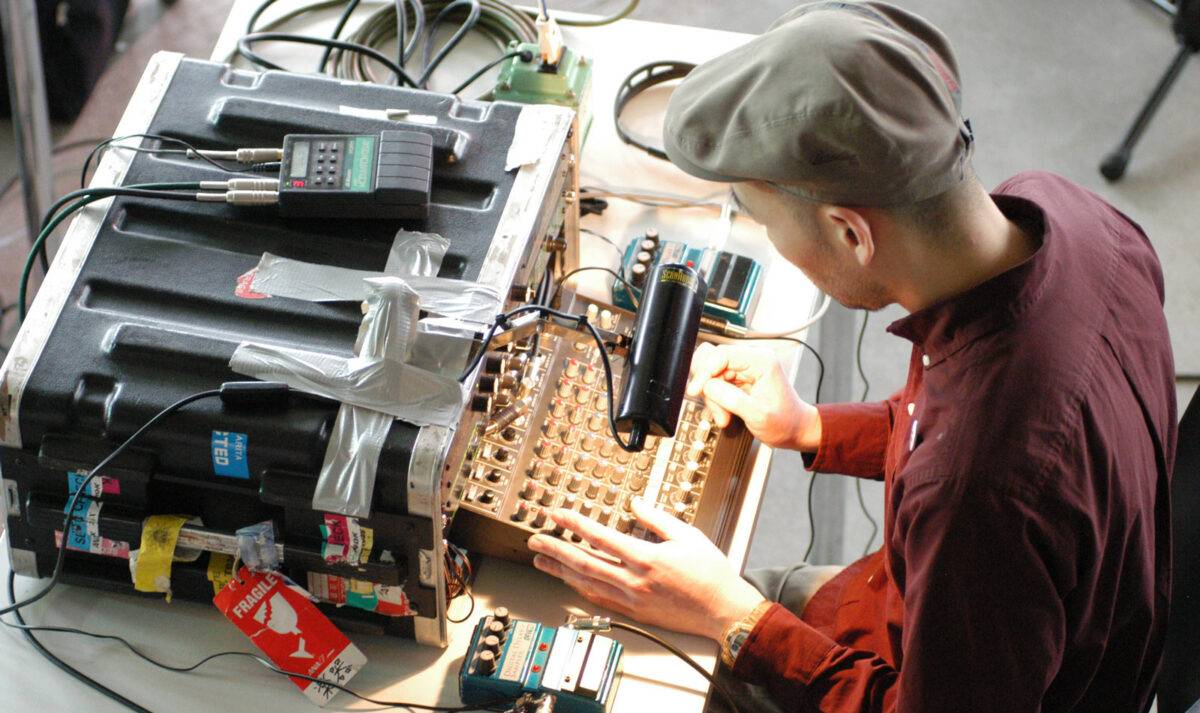
“This Might Cause Feedback”: Toshimaru Nakamura and the No-Input Mixing Board
Toshimaru Nakamura has blasted a set of speakers on occasion. However, listening to his 2000 debut album, No-Input Mixing Board, a subtle display of minimal musicianship, wouldn’t suggest music that could cause speakers to burn. What may be the culprit is his choice of instrument, the no-input mixing board, which forgoes any external audio input, instead feeding a mixing board’s output back into its input in defiance of the owner’s manual. Nakamura pioneered this instrument in the mid-1990s, contributing his feedback-driven improvisations to the abundant tapestry of Japanese noise and experimental music of the day. Nakamura’s debut has just been reissued on vinyl for the first time by Signal Records, further solidifying his legacy in experimental electronics.
Initially, Nakamura played guitar in the 1990s, performing in rock bands that flirted with elements of improvisation and jazz. Nakamura frequently felt a discomfort with performing on the guitar, and through a series of experiments one day, discovered the no-input mixing board. On this occasion in 1997, he was playing the guitar with effects into the mixing board, touching a string and adjusting the knobs on the mixer. As Nakamura progressed, he noticed he was utilizing the guitar less frequently, paying more attention to what he could do with the mixing board. He removed the guitar from the mixing board’s input, plugging the mixing board’s own output back into the input. The subsequent feedback and endless possibilities for how he could manipulate that feedback with the board’s knobs and faders created the no-input mixing board. Born was an instrument that didn’t play by the manual’s rules. As Nakamura said, “You might see a caution notice in a manual for a mixer if you buy one, saying ‘This might cause feedback.’”

Nakamura described to Perfect Sound Forever in 1993 what made the no-input mixing board so compelling to him, compared to the guitar. He stated, “When I played the guitar, ‘I’ had to play the guitar. But with the mixing board, the machine would play me and the music would play the other two, and I would do something or maybe nothing.” Reading this brought to mind my blog post from September about electronic composer Joel Chadabe, whose interactive music systems caused him to respond in real time to decisions made by a computer. Both Chadabe and Nakamura created musical partnerships between man and machine that required levels of trust, flexibility, and acquiescence of control to indeterminacy. As Nakamura further told Perfect Sound Forever, “If something happens naturally I want to keep it so, I don’t want to touch it.” This mindset even fed back into his later work on guitar, which Nakamura approached with the same equality between instrument and performer as he had with the no-input mixing board.
Nakamura’s development of the no-input mixing board was in step with the onkyo movement happening in Tokyo at the same time, led by Nakamura and fellow musicians Tetuzi Akiyama, Sachiko M, Taku Sugimoto, and others. Onkyo, which literally translates to “reverberation of sound,” was defined by its distinctively quiet sound which allowed for the noise of footsteps and passersby to intertwine with the music. As Matthew Blackwell wrote, “these outside sounds were welcome illustrations of onkyo’s core tenets of improvisation, spatial dynamics, and careful listening.” Clive Bell interprets onkyo as a lineage of and response to, whether conscious or not, to the prevalence of Japanese noise in the eighties and nineties. He said, “Looking deeper, it’s now clear that improvisation and noise already had a lengthy history in Japan. The guitar work of Takayanagi and Keiji Haino in the ‘80s flowed into the work of noise maestro Merzbow (Masami Akita) and Jojo Hiroshige’s guitar-trashing outfit Hijokaidan.”
The collaborative album, Good Morning Good Night (2004) is often considered a defining record of the onkyo movement, which brings together performances by Nakamura, Sachiko M, and Otomo Yoshihide (Ground Zero). The album is marked by the prevalence of silence only occasionally broken by the musicians. From 1998 to 2003, Nakamura ran a concert series called Improvisation Series at Bar Aoyama, and later a series called the Meeting at Off Site, a venue based in the Shinjuku area of Tokyo which was central to the onkyo movement. This music scene was powerful, but short-lived. Onkyo is considered as contextual to that period, a style of music no longer performed.
However, its history and legacy is still appreciated to this day, and a vinyl reissue of Nakamura’s 2000 debut album is certainly warranted. This album, titled No-Input Mixing Board and originally released by Zero Gravity on CD, sets the stage for Nakamura’s characteristic sound on the no-input mixing board, as well as establishes the versatility of the instrument. Its timbre on No-Input Mixing Board ranges from pure tone blips, to muted frequencies burbling under the surface, to high-pitched drones. Nakamura employs looped motifs that serve as the foundation for subtle changes in the texture. The album is highly rhythmic, texturally rich, and constantly varied.
Nakamura has released eleven solo studio albums, but he has also shown that the no-input mixing board can be a collaborative instrument as well, perhaps most notably with guitarist Keith Rowe (AMM). The pair have worked together on five records, beginning in 2001 with Weather Sky, in which “they respond to one another’s slightest movements to create an ever-shifting, but always unified sonic field.” It becomes unclear where the no-input mixing board ends and the guitar begins.
Toshimaru Nakamura’s ingenuity in creating the no-input mixing board completely upended the divide between audio equipment and musical instrument, showing that they could be one in the same. More no-input mixing board performers have followed, fascinated by an instrument that plays the musician as much as the musician plays it. And with just one listen of Nakamura’s first No-Input Mixing Board, it becomes clear the sonic possibilities are endless.
In the Shop
Toshimaru Nakamura – No Input Mixing Board LP – $24
Resources
Toshimaru Nakamura’s official website
Clive Bell, “Off Site: Improvised Music From Japan,” Red Bull Music Academy (2014)
Matthew Blackwell, “A Guide to Toshimaru Nakamura’s No-Input Mixing Board,” Bandcamp Daily (2022)
Dariotrapanimusic, “The Art of Noise: Toshimaru Nakamura Interview,” Musicoff (2017)
William Meyer, “Toshimaru Nakamura: Sound Student,” Perfect Sound Forever (2003)
“Toshimaru Nakamura: Profile,” Improvised Music from Japan (2014)
– Hannah Blanchette
January 29, 2023 | Blog